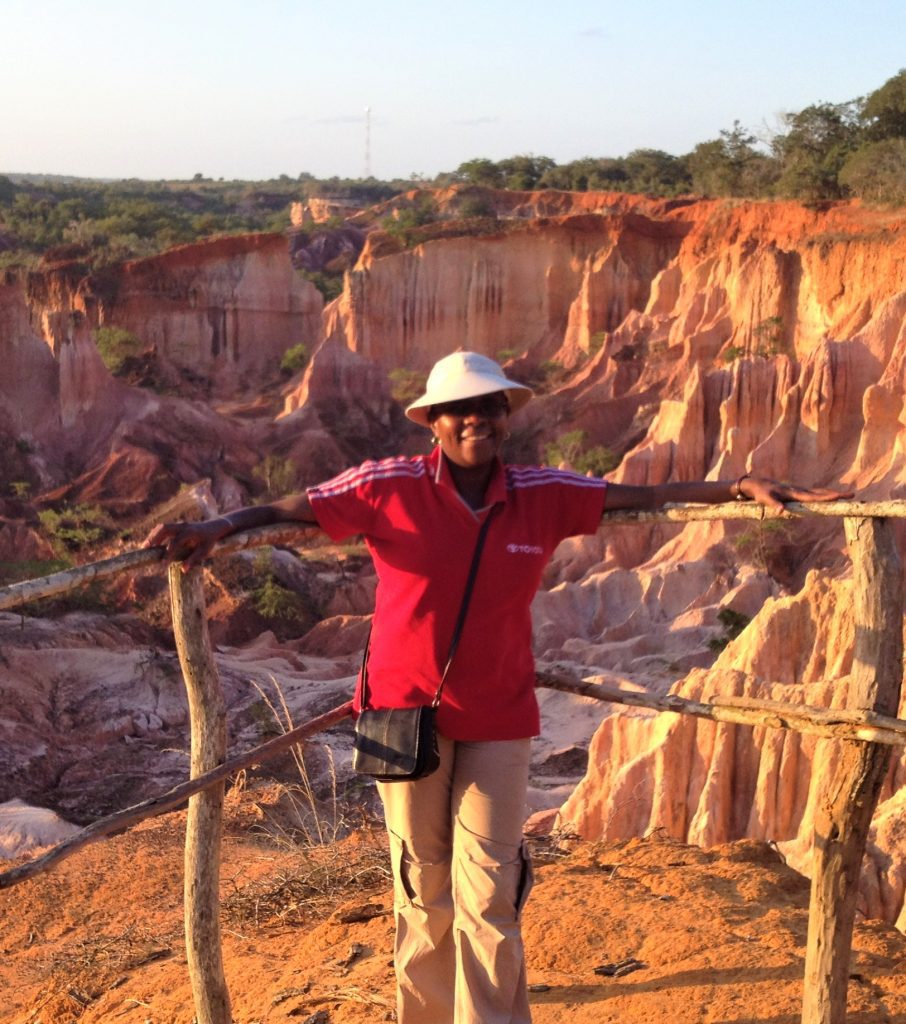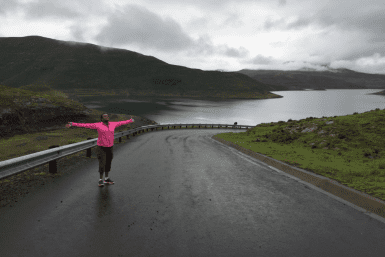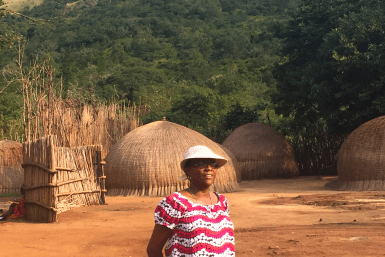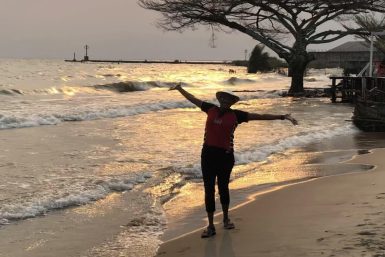As we approached the entrance, it wasn’t immediately evident that we’d arrived because the thick live fence blocked our view and the rusted white gate gave the impression of a neglected and abandoned compound. As soon as the gate was opened however, and we drove in through towards the parking, the gleam and shiny yellow-brown ridges peeping back at us from a distance, confirmed we were in the right place. While the gate looked derelict, the place was well manned by a group of young community folk who were to guide us in exploring one of nature’s grandest formations in the area.
Once payments were done and guide assigned, I was hardly able to restrain myself from moving towards the view point about 20m away, to behold the scenery before me.
Standing on the edge, behind a safety ledge because the drop beyond was crazy deep, I could see that the landscape below and all around for quite a distance, was distinctly different. I leaned forward in awe, to get a better view of the continuous rock-face split into ridges and hills, its layers differentiated by shades of red, pink, orange, yellow and brown. As the far as my eyes could see, the effect of the evening sun’s rays falling at different angles on the mounds, peaks, crevices and hillsides, was morphing them into changing shapes and shades, creating a magnificent feature of a little grand canyon, right here in Marafa!
“How did this come to be here?” I eagerly asked the guide as I tore my eyes away to look at him.
He explained that according to research and stories passed down over the centuries, the sandy landscape was sculptured by years of erosion and exposure to the elements, resulting in the unique geological formation. The natives call it Nyari, ‘the place broken by itself’. As long as the community had been around, with the climate alternating between extreme heat and periodic rains, the formation had evolved and changed subtly but surely, continuously curving, re-shaping and transforming its beauty ever so slightly into the different variations of shape and colour over time, even today.

The guide indicated that it was possible to descend on a path further down to get closer to its splendour, but warned that the temperatures were much higher down below, rising up to 50 degrees Celsius during the day – hence its name! With my response, ‘Wow! Can we?” he could see I was mesmerized and was happy with my appreciation for the spectacle before us. With a slight wave of his hand, he drew us away from the viewpoint heading towards the start of a slim path disappearing further into the depths of hell. 😉
It took some coaxing to drag the rest along but I was resolute. After all, we’d come all this way just for this purpose, and I could already feel the pull of the ‘spirits’ calling me to explore and get a taste of what an earthly hell looks and feels like.
As we manoeuvred the winding sandy path around the hills and few trees growing out of the solid rock-sides (fascinating that anything can grow and survive here!), we could feel the gentle rise in temperature. By then the sun was setting and it is difficult to explain how beautifully the shades of colour kept shifting from light, to darker and everything in between, depending on where the sun’s rays or the resultant shadows fell. The sparkle of reflection on the sand crystals was at times blinding and I had to look away. Worse still, there are open spaces between the hills and mounds where the hot wind at times got through, increasing our suffering!
From the ground perspective, I was totally dwarfed by the landscape with ridged hillsides rising out of the ground at 2m or much more at various points. They seemed endless as we walked along and around them. The darker orange-red patches at higher level looked like sand but when I touched them, found the sandy rock to be rock solid and hot! Moving slowly onward, at several points we couldn’t help but stop and admire the stunning kaleidoscope display of colour, across the various formations. Inadvertently, this resulted in some looking like human forms such as a man’s head, aged faces, animals or anything a wild imagination could think up.
Eventually, with the sun disappearing in the horizon, it was getting darker and beginning to look as hellish as it was feeling. It was time to leave and we followed our guide hurriedly out, happily ascending back to cooler earth level before sundown.
Nothing other than darkness could have torn me away, so with reluctance we said our goodbyes and headed back to the town. We had some interesting discussions on similarities of the experience with the description of biblical hell. That we get easily attracted by earthly pleasures, looking beautiful and shiny, and we happily indulge until hooked, only to realise we’ve been lured to unbearable heat of eternal fire!
Hell’s Kitchen is located in Marafa which is about 40 km from Malindi town (63km from Watamu), hidden inland within the cooler and drier, rural side of the county. You need to set off on the Malindi-Garsen road heading northward until you pass the Sabaki Bridge by about 500m, where you’ll turn left onto a feeder road headed to your destination. It takes an hour or longer depending on your start point and the road conditions.
The next time you are in Malindi, make time to go a little out of your way, and marvel at this hidden gem. For obvious reasons the best time to visit is just before Sunset (to get the most beauty out of the sun lighting). Go ahead and descend to ground level for more fascination and study.
And if you dare, be prepared to experience the searing heat, to get a true taste of Hell’s Kitchen! Do you know about this place? Have you been there? Was your experience similar?





Leave a reply